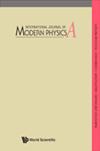On the gravitational diagram technique in the discrete setup
IF 1.4
4区 物理与天体物理
Q3 PHYSICS, NUCLEAR
引用次数: 0
Abstract
This article is in the spirit of our work on the consequences of the Regge calculus, where some edge length scale arises as an optimal initial point of the perturbative expansion after functional integration over connection. Now consider the perturbative expansion itself. To obtain an algorithmizable diagram technique, we consider the simplest periodic simplicial structure with a frozen part of the variables ("hypercubic"). After functional integration over connection, the system is described by the metric $g_{\lambda \mu}$ at the sites. We parameterize $g_{\lambda \mu}$ so that the functional measure becomes Lebesgue. The discrete diagrams are finite and reproduce (for ordinary, non-Planck external momenta) those continuum counterparts that are finite. We give the parametrization of $g_{\lambda \mu}$ up to terms, providing, in particular, additional three-graviton and two-graviton-two-matter vertices, which can give additional one-loop corrections to the Newtonian potential. The edge length scale is $\sim \sqrt{ \eta }$, where $\eta$ defines the free factor $ ( - \det \| g_{\lambda \mu} \| )^{ \eta / 2}$ in the measure and should be a large parameter to ensure the true action after integration over connection. We verify the important fact that the perturbative expansion does not contain increasing powers of $\eta$ if its initial point is chosen close enough to the maximum point of the measure, thus justifying this choice.论离散装置中的引力图技术
本文章由计算机程序翻译,如有差异,请以英文原文为准。
求助全文
约1分钟内获得全文
求助全文
来源期刊
CiteScore
3.00
自引率
12.50%
发文量
283
审稿时长
3 months
期刊介绍:
Started in 1986, IJMPA has gained international repute as a high-quality scientific journal. It consists of important review articles and original papers covering the latest research developments in Particles and Fields, and selected topics intersecting with Gravitation and Cosmology. The journal also features articles of long-standing value and importance which can be vital to research into new unexplored areas.

 求助内容:
求助内容: 应助结果提醒方式:
应助结果提醒方式:


